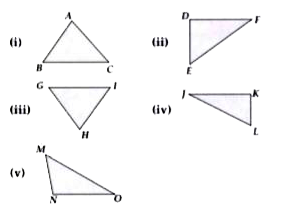Can a triangle have: Two right angles? (ii) Two obtuse angles? Two acute angles (iv) All angles more than 600 ? All angles less than 600 ? (vi) All angles equal to 600
Solution:
(i) Let a triangle 'ABC' has two angles equal to . We know that sum of the three angles of a triangle is '180@'
Hence, if two angles are equal to , then the third one will be equal to zero which implies that 'A, B,C'is collinear, or we can say 'ABC' is not a triangle.
A triangle can’t have two right angles.
(ii) Let a triangle 'ABC' has two obtuse angles
This implies that sum of only two angles will be equal to more than '180@' which contradicts the theorem sum of all angles in a triangle is always equals '180@'.
Therefore, a triangle can’t have two obtuse angles.
(iii) Let a triangle 'ABC' has two acute angles.
This implies that sum of two angles will be less than . Hence third angle will be the difference of '180@' and sum of both acute angles
Therefore, a triangle can have two acute angles.
(iv) Let a triangle 'ABC' having angles are more than '60@ .
This implies that the sum of three angles will be more than '180@' which contradicts the theorem sum of all angles in a triangle is always equals '180@'.
Therefore, a triangle can’t have all angles more than .
(v) Let a triangle 'ABC' having anglesare less than '60@'.
This implies that the sum of three angles will be less than 180° which contradicts the theorem sum of all angles in a triangle is always equals '180@'.
Therefore, a triangle can’t have all angles less than '60@'.
(vi) Let a triangle ABC having angles all equal to '60@'.
This implies that the sum of three angles will be equal to '180@' which satisfies the theorem sum of all angles in a triangle is always equals '180@'.
Therefore, a triangle can have all angles equal to '60@'.
Topper's Solved these Questions
Similar Questions
Can a triangle have
two rght angles?
two abtuse angles?
two acute angles?
all angles more than 60∘
all angles less than 60∘?
all angles to 60∘?View SolutionCan a triangle have two obtuse angles? Why?
View SolutionExplain whether a triangle can have two right angles. Can it have two obtuse angles?
View SolutionCan a triangle have two obtuse angles ? Give reason for your answer.
View SolutionIs it possible to have triangle, in which Two of the angles are right? Two of the angles are obtuse? Two of the angles are acute? Each angle is less than 600? Each angle is greater than 600? Each angle is equal to 600? Give reason in support of your answer in each case.
View SolutionGive two measures of (i) acute angle (ii) obtuse angle.
View SolutionFill in the blanks to make the following statements true: Sum of the angles of a triangle is ............ An exterior angle of a triangle is equal to the two ............ opposite angles. An exterior angle of a triangle is always ............ than either of the interior opposite angles. A triangle cannot have more than ............ right angles. A triangles cannot have more than ............ obtuse angles.
View SolutionClassify these triangles as right, acute or obtuse angled triangle.
 View Solution
View SolutionTwo acute angles of a right triangle are equal. Find the two angles.
View Solutionin one angle of a right triangle is 60∘ ,the other two angle are
View Solution

